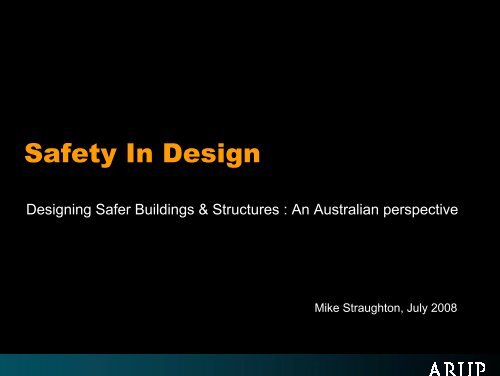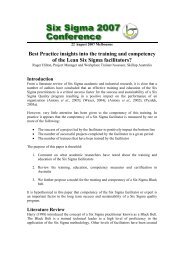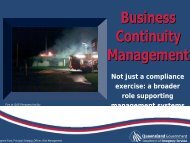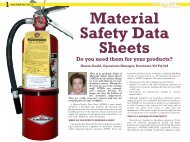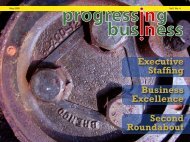Safety In Design
Safety In Design
Safety In Design
Create successful ePaper yourself
Turn your PDF publications into a flip-book with our unique Google optimized e-Paper software.
<strong>Safety</strong> <strong>In</strong> <strong>Design</strong><br />
<strong>Design</strong>ing Safer Buildings & Structures : An Australian perspective<br />
Mike Straughton, July 2008
<strong>In</strong>troduction<br />
• Why the Move to <strong>Safety</strong> <strong>In</strong> <strong>Design</strong>?<br />
• The Regulatory Push Towards <strong>Safety</strong> in <strong>Design</strong><br />
• Duties for <strong>Design</strong>ers of Buildings or Structures<br />
• Definitions<br />
• Who is a <strong>Design</strong>er?<br />
• What are the <strong>Design</strong>er’s Responsibilities When Preparing a<br />
<strong>Design</strong>?
<strong>In</strong>troduction<br />
• <strong>Safety</strong> <strong>In</strong> <strong>Design</strong><br />
• An Example of a Risk Management Approach<br />
• Benefits of <strong>Safety</strong> <strong>In</strong> <strong>Design</strong><br />
• Practicable Examples of <strong>Safety</strong> in <strong>Design</strong><br />
• Benefits of <strong>Safety</strong> in <strong>Design</strong>
Why the Move to <strong>Safety</strong> <strong>In</strong> <strong>Design</strong>?<br />
• Safe engineering design integrates risk management<br />
principles into the design by<br />
• <strong>In</strong>volving designers, users, and other relevant parties in considering the<br />
most appropriate design at each stage in the design process<br />
• Systematically identifying hazards, and eliminating/mitigating<br />
associated risks<br />
• Communicating to the users, and other relevant parties, residual risks<br />
associated with the design
The Regulatory Push Towards <strong>Safety</strong> in <strong>Design</strong><br />
• United Kingdom<br />
• Construction (<strong>Design</strong> & Management) Regulations 2007<br />
• Australia<br />
• Federal<br />
• National Standard for Construction Work<br />
• States/Territories<br />
• As with other OH&S legislation, various states/territories have “variations (to<br />
a greater or lesser extent) on the same theme”
Legislative Framework:<br />
Commonwealth: National Construction Standard<br />
NT: No specific duties<br />
Northern<br />
Territory<br />
QLD: WH&S Act 1995: s30B<br />
Queensland<br />
Western<br />
Australia<br />
A: OS&H Act 1984: s23<br />
South<br />
Australia<br />
New South<br />
Wales<br />
ACT<br />
NSW: No specific duties<br />
ACT: No specific duties<br />
SA: OHS & W Act 1986: s23A<br />
Victoria<br />
VIC: OHS Act 2004: s28<br />
Tasmania<br />
TAS: WH&S Act 1995: s14
Duties for designers of buildings or structures<br />
• Depending on the jurisdiction, the duty applies to designers<br />
of:<br />
• buildings /structures to be used as workplaces<br />
• buildings/structures that are occasional workplaces<br />
• parts of the building/structure including fixtures integral to its use as a<br />
workplace<br />
• temporary structures<br />
• the design of the construction and demolition phases of a building/<br />
structure’s lifecycle (not all jurisdictions)<br />
• Roads and footpaths (not all jurisdictions)<br />
• The duty doesn’t apply to<br />
• Residential dwellings not intended as workplaces
Duties for designers of buildings or structures<br />
• Commonwealth: National Construction Standard (section 7)<br />
requires that designers must<br />
• Ensure that hazards associated with the construction work (includes<br />
construction, repair, cleaning, maintenance, demolition) required by the<br />
design are identified before commencement of that work<br />
• Ensure to the extent that they have control over the design that health<br />
& safety risks resulting from the design are eliminated or minimised<br />
• Provide a written report to the client on the health & safety aspects of<br />
the design
Duties for <strong>Design</strong>ers of Buildings or Structures<br />
• Queensland: section 30B of the WH&S Act 1995 states<br />
• Section 30B (Obligations of <strong>Design</strong>ers of Structures)<br />
• <strong>Design</strong>er of a structure has an obligation to ensure the design of the<br />
structure does not affect the WH&S of persons<br />
• During construction of the structure<br />
• When the structure has been constructed and is being used for the purpose<br />
it was originally designed for<br />
• A designer is considered to have met their obligation under section 30B<br />
if persons are not exposed to risks to their H&S arising out of the<br />
design This places an absolute duty on the designer
Definitions Used in Queensland<br />
• Workplace<br />
• Any place where work is, or is to be, performed by a worker or a person<br />
conducting a business or undertaking<br />
• Building or Structure<br />
• Structure: definition is very broad and includes a building, underground works,<br />
roads, footpaths, railway lines, water storages/supply systems, formwork,<br />
falsework, scaffold or other construction designed for use during construction<br />
work<br />
• As Far as Reasonably Practicable needs to take in to account<br />
• General OH&S duties are not qualified by the term “reasonably practicable” –<br />
the defendant has the onus of proof that an offence was not committed
Who is a designer?<br />
• <strong>Design</strong>ers can include:<br />
• Persons who undertake the design<br />
on behalf of a client, including:<br />
• Architects<br />
• Building designers<br />
• Draftspersons<br />
• Client (e.g. if they specify a certain<br />
design)<br />
• Persons who design parts of the<br />
building/structure integral to its use<br />
as a workplace, including:<br />
• Engineers<br />
• <strong>In</strong>terior designers<br />
• <strong>In</strong>dustrial designers<br />
• Contractors<br />
• Persons who make changes to<br />
building/structure design during the<br />
construction phase have a safety in<br />
design duty<br />
Pre-<strong>Design</strong>:<br />
Siting, Feasibility Study<br />
Conceptual & Schematic<br />
<strong>Design</strong><br />
<strong>Design</strong> Development<br />
Construction<br />
Documentation<br />
Construction,<br />
Refurbishment or<br />
Modification
What are the designer’s responsibilities when<br />
preparing a design?<br />
• To Understand<br />
• the range of work activities associated with intended use of<br />
building/structure as a workplace<br />
• any maintenance, repair, service and cleaning activities for building /<br />
structure when in use (also demolition in some jurisdictions)<br />
• To Identify, and Control<br />
• hazards and risks associated with the above activities<br />
• To Communicate:<br />
• inform the client of any high risks in the client’s design requirements<br />
• recommend design alternatives that will eliminate/reduce risks arising<br />
from original design
Who else has responsibilities?<br />
• Basically, anyone who has input into the design, construction and<br />
use of the building/structure as a workplace e.g.<br />
• Clients<br />
• Construction contractors building the workplace<br />
• <strong>Design</strong>ers, manufacturers & suppliers of plant to be used in the<br />
workplace<br />
• Controller of the workplace<br />
• Employees who will be using the workplace<br />
• Persons installing, erecting, commissioning, maintaining plant at the<br />
workplace
Who else has responsibilities?<br />
• Queensland’s WH&S Act safety in design obligations are more<br />
detailed than other jurisdictions, with specific responsibilities<br />
detailed in<br />
• Section 23 (Obligations for Workplace Health & <strong>Safety</strong>)<br />
• Section 30A (Obligations of Clients)<br />
• Section 30B (Obligations of <strong>Design</strong>ers of Structures)<br />
• Section 30C (Obligations of Project Managers)<br />
• Section 31 (Obligations of Principal Contractors)
Queensland WH&S Act<br />
• Section 23 (Obligations for Workplace Health & <strong>Safety</strong>)<br />
• <strong>Design</strong>ers of structures have an obligation to ensure workplace health<br />
& safety for construction work and makes reference to amended<br />
section 30B<br />
• Defines a number of other parties that have obligations to ensure<br />
workplace H&S
Queensland WH&S Act<br />
• Section 30A (Obligations of Clients)<br />
• Client has an obligation to consult with<br />
• <strong>Design</strong>er<br />
• Project Manager for construction work<br />
• Principal Contractor for construction work<br />
• Aim of consultation is to<br />
• Ensure the construction work can be planned and managed so as to<br />
prevent or minimise all risk s to health and safety<br />
• <strong>In</strong>form the <strong>Design</strong>er, Project Manager, or Principal Contractor of any<br />
hazards or risks that the client is aware of relating to the site where<br />
construction is to occur
Queensland WH&S Act<br />
• Section 30C (Obligations of Project Managers)<br />
• Project Manager of a structure has an obligation to ensure<br />
construction work is planned and managed to prevent or minimise risk<br />
to the the WH&S of all persons<br />
• Undertaking the construction work<br />
• Person at or near the workplace during the construction work
Queensland WH&S Act<br />
• Section 31 (Obligations of Principal Contractors)<br />
• Principal Contractor has an obligation to ensure the the WH&S of all<br />
persons arising from a hazard at the workplace for which no other<br />
person has an H&S obligation<br />
• Principal Contractor must manage construction work so as to prevent<br />
or minimise risk<br />
• Principal Contractor must consult with following parties re construction<br />
work risk management<br />
• The <strong>Design</strong>er<br />
• The Project Manager<br />
• Other relevant persons
<strong>Safety</strong> in <strong>Design</strong> – lifecycle approach<br />
Operation<br />
Construction<br />
<strong>Safety</strong> <strong>In</strong> <strong>Design</strong><br />
Maintenance<br />
and Repair<br />
Demolition/<br />
Refurbishment
Risk management approach<br />
Review<br />
Options<br />
No<br />
Identify<br />
Hazards<br />
What could<br />
go wrong?<br />
Assess<br />
Risks<br />
• Quantify<br />
•Rank<br />
Identify<br />
Control<br />
Measures<br />
• Mitigation<br />
• Management<br />
• Control<br />
Is<br />
Residual<br />
Risk<br />
Acceptable<br />
?<br />
Yes<br />
RISK REGISTER<br />
Implement<br />
Control<br />
Measures<br />
Monitor<br />
Update risk<br />
register
<strong>Safety</strong> in <strong>Design</strong> Reviews<br />
• Brainstorm ideas at review with fellow design team members<br />
• Identify hazards and risks<br />
• May require completion of full or partial risk management<br />
• Then evaluate them:<br />
• What can be avoided, reduced or controlled<br />
• Record your decisions<br />
• Communicate to client
<strong>Safety</strong> in <strong>Design</strong> Reviews<br />
Key outcomes<br />
• List any required actions that may be required as part of future<br />
design phases<br />
• Ensure all relevant information is captured and recorded<br />
• Communicate the findings of the review to all relevant parties,<br />
including the client<br />
• Any review report developed should include<br />
• review methodology used<br />
• details regarding any significant risks identified during the review<br />
• Follow-up actions generated from review
Practicable Examples of <strong>Safety</strong> in <strong>Design</strong><br />
Bulk sulphur shed<br />
• Use of front-end loader has<br />
several potential hazards<br />
• Stockpile collapse on to loader<br />
• Generation of dust due to<br />
crushing of product<br />
• Operator exposure to dust<br />
• Potentially explosive air/dust<br />
mixture<br />
• Loader is a potential ignition<br />
source<br />
• Sparking from bucket striking<br />
concrete floor<br />
• Friction between loader tyres and<br />
floor<br />
• Sparking from Loader engine<br />
• Use of Auto-reclaim system<br />
eliminates/minimises above<br />
hazards
Practicable Examples of <strong>Safety</strong> in <strong>Design</strong><br />
Building atrium<br />
• Significant amount of internal<br />
glass to be cleaned, including<br />
internal skylight at approx 12<br />
metres above floor level<br />
• <strong>In</strong>itial access solution did not<br />
involve building maintenance<br />
contractor<br />
• Complicated and<br />
impracticable<br />
• Ultimate access solution<br />
provided primarily by<br />
maintenance contractor<br />
• Simple and practicable
Practicable Examples of <strong>Safety</strong> in <strong>Design</strong><br />
Building atrium
Portable Ladde<br />
Practicable Examples of <strong>Safety</strong> in <strong>Design</strong><br />
<strong>In</strong>itial access solution<br />
Fall Arrest Rigging to<br />
Full Body Harness<br />
System<br />
Ladder <strong>In</strong>termediate<br />
Support
Practicable Examples of <strong>Safety</strong> in <strong>Design</strong><br />
Building atrium<br />
• Ultimate access solution
Practicable Examples of <strong>Safety</strong> in <strong>Design</strong><br />
Residential precinct road design<br />
• Uninterrupted street lengths<br />
restricted to minimise risk of<br />
traffic travelling at speed, with<br />
controls including<br />
• Roundabouts<br />
• Road closures<br />
• Reorientation of streets<br />
• Stagger of streets
Practicable Examples of <strong>Safety</strong> in <strong>Design</strong><br />
• Elimination of working at height during maintenance of light fittings
Practicable Examples of <strong>Safety</strong> in <strong>Design</strong><br />
• Working from fixed platform during maintenance of light fittings
Practicable Examples of <strong>Safety</strong> in <strong>Design</strong><br />
• 100m high<br />
(yellow) support<br />
towers require<br />
aircraft warning<br />
lights<br />
• Each tower<br />
has two lights<br />
in parallel –<br />
when one fails,<br />
second is<br />
switched on –<br />
adequate<br />
coverage for<br />
original life<br />
expectancy for<br />
structure
Practicable Examples of <strong>Safety</strong> in <strong>Design</strong><br />
• 40m high mast on top of<br />
203m tower requires aircraft<br />
warning light<br />
• Eyebolts as part of height<br />
access solution<br />
impracticable – periodic<br />
testing of eyebolts would be<br />
required<br />
• Solution – approved light<br />
fitting that can be<br />
raised/lowered up centre of<br />
mast (mast centered on<br />
500mm dia. Steel tube)
<strong>Safety</strong> in <strong>Design</strong><br />
– it’s not just about permanent works!<br />
Prevention of<br />
fall in to pile<br />
during<br />
construction<br />
~ 1.2 m of temporary<br />
steel casing above<br />
ground<br />
~ 0.6 – 1.5 m diameter<br />
pile<br />
Temporary steel casing<br />
used to support ground<br />
at top of pile during<br />
construction
<strong>Safety</strong> in <strong>Design</strong><br />
– it’s not just about permanent works!
<strong>Safety</strong> in <strong>Design</strong><br />
– it’s not just about permanent works!
Benefits of <strong>Safety</strong> in <strong>Design</strong><br />
Lifecycle Phase<br />
<strong>Design</strong><br />
Construction<br />
Operation<br />
Maintenance and<br />
Repair<br />
Demolition/<br />
Refurbishment<br />
Health and <strong>Safety</strong> Benefit<br />
• Risks identified<br />
• Risks reduced/controlled<br />
• Communication of residual risks to<br />
contractor<br />
• Reduced likelihood of accidents<br />
• Occupant health and safety<br />
• Public health and safety<br />
• Safe access for maintenance and<br />
repair strategies<br />
• Reduced likelihood of accidents<br />
• Communication of residual risks to<br />
contractor<br />
• Reduced likelihood of unplanned<br />
events<br />
• <strong>In</strong>formed contractor reduces risk<br />
contingency<br />
• <strong>In</strong>creased time and cost certainty<br />
• Reduced costs (absence & claims)<br />
• Company image<br />
Project Benefit<br />
• Reduced re-design or retrofitting<br />
• Reduced lifecycle OHS costs<br />
• Reduced civil claims<br />
• <strong>In</strong>formed contractor reduces risk<br />
contingency<br />
• Reduction in maintenance costs<br />
• Reduction in repair costs<br />
• <strong>In</strong>formed contractor reduces risk<br />
contingency<br />
• <strong>In</strong>creased time and cost certainty


